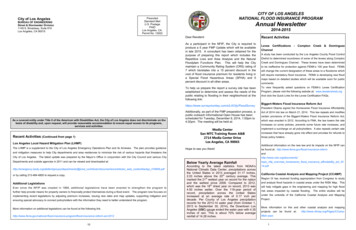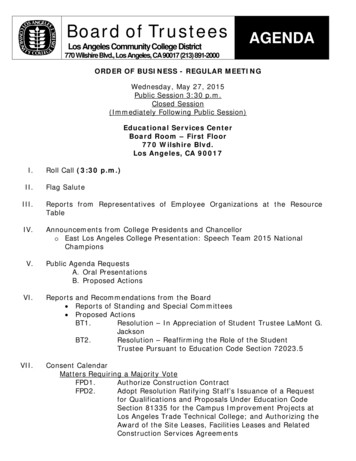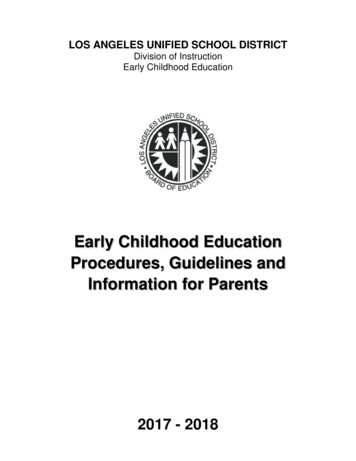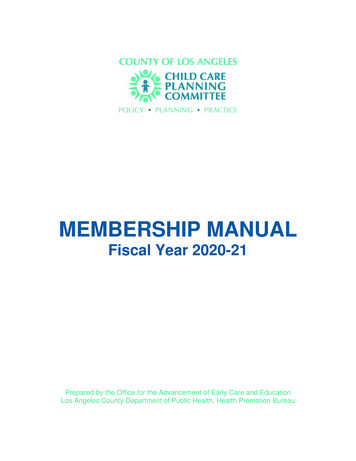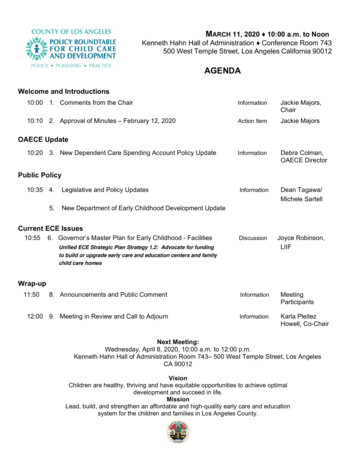
Transcription
County of LosAngeles ProgramsServing PeopleExperiencingHomelessnessCounty of Los AngelesChief Executive Office, Homeless InitiativeOctober 2020HOA.103038182.1
COUNTY OF LOS ANGELESPROGRAMS SERVING PEOPLE EXPERIENCING HOMELESSNESSTable of Contents1. Department of Children & Family Services 32. Department of Health Services . 33. Department of Mental Health 44. Department of Public Health . 65. Department of Public Social Services 86. Los Angeles Homeless Services Authority . 97. Los Angeles County Development Authority . 108. Los Angeles Sheriff’s Department . 129. Probation Department 1210. Public Defender 1211. Workforce Development, Aging & Community Services . 131 Page
COUNTY OF LOS ANGELESPROGRAMS SERVING PEOPLE EXPERIENCING HOMELESSNESSThis County of Los Angeles' Comprehensive Homelessness Program document describes programs fundedby the County for housing and services to individuals and families who are experiencing homelessness,formerly homeless or at-risk of homelessness in Los Angeles County. Some programs included in thisdocument serve both families/individuals with no connection to homelessness and those with aconnection to homelessness; those programs are identified with an asterisk.Homeless Programs included in this document are funded within the departmental or agency budgets forthe following: Department of Children and Family Services (DCFS)Department of Health Services (DHS)Department of Mental Health (DMH)Department of Public Health (DPH)Department of Public Social Services (DPSS)Los Angeles County Development Authority (LACDA)Los Angeles Homeless Services Authority (LAHSA)Los Angeles Sheriff’s Department (LASD)ProbationPublic DefenderWorkforce Development, Aging and Community Services (WDACS)Funding, which is budgeted to one department/agency and then transferred to anotherdepartment/agency, is listed under the department/agency which is the ultimate recipient of the funding.2 Page
COUNTY OF LOS ANGELESPROGRAMS SERVING PEOPLE EXPERIENCING HOMELESSNESSDepartment of Children & Family Services1. Strategy A1 Homeless Prevention for Families - A pilot for a Prevention and Aftercare Program toassist families who are referred to DCFS, do not have an open DCFS case, and have unstable housing.2. Strategy A5 Homeless Prevention for Individuals - A pilot focused on transition age youth who needadditional services to take advantage of the Supervised Independent Living Program (SILP).3. Strategy B6 - Family Reunification Housing Subsidy - Strategy B6 provides rapid re-housing and casemanagement services to families in the child welfare system where the parent(s)’ homelessness is the solebarrier to the return of the child(ren), and the family meets eligibility criteria.4. Bringing Families Home (BFH) - BFH provides direct financial assistance and supportive services tofamilies in the Family Maintenance Program under the Department of Children and Family Services (DCFS).The program aims to assist families to locate housing and prevent children from entering or re-entering intofoster care.Department of Health Services1. Clinical Services (Stress, Trauma and Resilience (STAR) & Union Rescue Mission (URM) Clinic - Funds tooperate medical clinics located in the Skid Row area offering a medical home and specialty services forpeople who are homeless or formerly homeless.2. Office of Diversion and Re-Entry* - Office of Diversion and Re-entry offers interim housing (IH) andpermanent supportive housing (PSH) for justice-involved individuals diverted from jail.3. Whole Person Care* - Whole Person Care Pilot (WPC) is a 5-year program created under California'sMedicaid Section 1115 waiver to provide integrated care for the most vulnerable group of Medi-Calbeneficiaries who have been identified as high users of multiple systems and continue to have poor healthoutcomes. WPC-LA’s costs include direct program costs as well as administrative and delivery infrastructureexpenditures for the Medi-Cal clients from several high-risk populations (homeless, justice-involved, mentalhealth, substance use disorder and medically high-risk).4. Strategy B3 - Rapid Re-Housing - Provides homeless families and individuals with time-limited financialassistance, case management, targeted supportive services, and housing navigation.5. Strategies B7 and E8 - Interim Housing - Supports a variety of short-term housing environments thatprovide a safe environment for people experiencing homelessness to sleep and to be assessed for longterm stability, including permanent housing, health, mental health, and other supportive services.6. Strategy E8 Capital Improvement Intermediary - Capital Projects - Supports capital improvementprojects approved by LA County that expand interim housing and supportive services for homelessindividuals.7. Strategy E6 - Outreach System - Provides approximately 60 Multidisciplinary Teams (MDTs) throughoutLos Angeles County that provide outreach and engagement to unsheltered people experiencing3 Page
COUNTY OF LOS ANGELESPROGRAMS SERVING PEOPLE EXPERIENCING HOMELESSNESShomelessness to connect them to housing, supportive services, and sources of income. Each team consistsof a health professional, mental health specialist, substance abuse counselor, case manager, and someonewith lived experience. The MDTs operate 7 days a week, and operate a drop-in location serving some of themost vulnerable unsheltered residents of Skid Row.8. Strategy C4/5/6 - Disability Benefits Advocacy - Provides targeted benefit advocacy services to assistindividuals who are homeless or at-risk of homelessness in obtaining sustainable income through programssuch as Supplemental Security Income (SSI), Social Security Disability Income (SSDI), Cash AssistanceProgram for Immigrants (CAPI), and Veteran benefits.9. Strategy D2 - Jail In Reach - Provides supportive services for homeless incarcerated individuals in orderto avoid discharges into homelessness. Services are provided by community-based organizations.10. Strategy D7 - Permanent Supportive Housing - Supports permanent supportive housing includingintensive case management services, local rental subsidies and high-quality tenancy support services, andclinical services, as well as placements into and enhanced services in licensed care facilities, whereappropriate.11. Strategy A5 Homeless Prevention for Individuals - A new Homelessness Prevention Unit focused onCounty single adult clients at the greatest risk of becoming homeless as identified by the California PolicyLab using predictive analytics.13. COVID-19 - Housing for Health (HFH) - Supports COVID-related projects operated by HFH includingmedical sheltering and infection control measures provided by COVID Response Teams (CRTs) inunsheltered and sheltered settings.14. COVID-19 - To provide certain services for the benefit of COVID-19 impacted individuals includingsupporting COVID-19 testing and providing services to support building capacity of outreach teams andinterim housing providers who provide services to people experiencing homelessness.Department of Mental Health1. Enriched Residential Care (ERC) Program - Assists DMH clients to obtain and maintain housing at alicensed residential facility (Board & Care) by providing assistance for rent, personal and incidental expensesand/or enhanced services that may be needed due to their mental illness. Supports clients Countywide.Participants include both those who are homeless and those exiting higher levels of care that need housing.2. Emergency Enhanced Shelter Program - Transition-Age Youth (TAY) - Provides DMH TAY clients (ages18-25) who are homeless and have a mental illness with short-term housing that provides a bed, 24-hourgeneral oversight, three meals each day, linens, clothing, toiletries and case management services. Fundssites in Service Planning Area (SPA) 4, with a site in SPA 6 pending.3. Housing for Mental Health - Supports housing subsidies, security deposits, utility assistance andhousehold goods for DMH clients who are homeless and enrolled in a Full-Service Partnership (FSP)program. Twenty percent of housing subsidies are for FSP clients referred by the Office of Diversion and Reentry (ODR).4 Page
COUNTY OF LOS ANGELESPROGRAMS SERVING PEOPLE EXPERIENCING HOMELESSNESS4. Homeless FSP Program - Field-based teams provide ongoing, intensive outreach, mental health and casemanagement services tailored to meet the complex needs of individuals who are homeless and have aserious mental illness including assisting them with securing permanent housing.5. Homeless Outreach & Mobile Engagement (HOME) Program - Field-based teams provide outreach andengagement services to individuals who are homeless and have a serious mental illness with the goal oflinking them to ongoing mental health services and permanent housing.6. Housing Assistance Program (HAP) - Provides DMH clients who are homeless or at-risk of homelessnessand who have limited or no income with funds for housing subsidies, security deposits, utility assistance,household goods and eviction prevention assistance.7. MHSA Housing FSP Program - Provides field-based/on-site mental health services to individuals whohave a serious mental illness and are living in permanent housing in order to promote housing stability andretention.8. Innovative Coordinated Employment - Aims to create a network of businesses within a community thatwill provide competitive job opportunities to individuals who have a serious mental illness and who areformerly homeless and living in permanent supportive housing. Supports services in Long Beach.9. Integrated Mobile Health Team (IMHT) FSP Program - Field-based teams partner with a FederallyQualified Health Center to provide integrated care to individuals who are homeless and have co-occurringmental health, physical health and/or substance use disorders. Supports services in SPAs 4, 5 and 8.10. Intensive Case Management Services (ICMS) - Provides field-based/on-site case management servicesto individuals with serious mental illness who are living in permanent housing in order to promote housingstability and retention.11. Interim Housing Program - Provides DMH clients who are homeless and have a serious mental illness(as well as their minor children) with short-term housing that provides a bed, 24-hour general oversight,three meals each day, linens, clothing, toiletries and case management services.12. Prevent Homelessness Promote Health - Provides housing retention services to individuals/familiesin permanent housing who have a serious mental illness, are formerly homeless and are at-risk of losingtheir housing.13. Homeless Mentally Ill Outreach and Treatment Program - Provides capital development funding forinterim housing.14. Strategy E8 - Enhance the Emergency Shelter System - Supports one DMH staff who is co-located withDHS to triage Interim Housing Program (IHP) referrals and determine the most appropriate IHP placementfor a referred individual. Staff also monitors IHP contracts.15. Strategy B7 - Interim/ Bridge Housing for Those Exiting Institutions - Supports one DMH staff who isco-located with DHS to triage Interim Housing Program (IHP) referrals and determine the most appropriateIHP placement for a referred individual. Staff also monitors IHP contracts.5 Page
COUNTY OF LOS ANGELESPROGRAMS SERVING PEOPLE EXPERIENCING HOMELESSNESS16. Strategy C4/5/6 - Countywide Benefits Entitlement Services Teams (CBEST) - Supports DMH staffworking to assist individuals who are homeless and have a serious mental illness with obtaining benefitsincluding SSI.17. Strategy D7 - Provide Services and Rental Subsidies for Permanent Supportive Housing - SupportsDMH's Measure H Housing FSP Program, which provides field-based/on-site mental health services toindividuals who have a serious mental illness and are living in permanent housing in order to promotehousing stability and retention. Strategy D7 also supports the DMH staff who support this program.18. Veterans Peer Access Network (VPAN)* - Provides outreach, case management and mental healthservices to Veterans who have a serious mental illness. Approximately 85% of VPAN clients are homelessor at-risk of homelessness. Supports clients Countywide.19. Assisted Outpatient Treatment (AOT) Program* - Provides outreach to individuals who have a seriousmental illness and are at substantial risk of deterioration as a direct result of poor psychiatric treatmentcompliance, to voluntarily engage them in Full-Service Partnerships (FSP) or residential-type services in anInstitutions for Mental Disease (IMD) step-down facility. Approximately 41% of AOT clients are homeless.20. Intensive Service Recipient (ISR)/Kin to Peer (KTP) Programs* - Provide individuals who have a seriousmental illness and a recent history of psychiatric inpatient hospitalizations with a range of supportiveservices to prevent future psychiatric hospitalizations. Approximately 90% of ISR/KTP clients are homeless.21. CalWORKs Coordinated Entry System for Families (CESF) - Provides co-located clinicians at homelessservices agencies to screen families for mental health concerns and provide linkage to needed servicesincluding mental health services.Department of Public Health1. Substance Abuse Prevention and Control (SAPC)* - Administers Drug Medi-Cal substance use disorder(SUD) services through contracts with 80 community-based certified and/or licensed SUD treatmentprograms at 443 locations countywide. Treatment services offered to SAPC’s homeless population (20-25%of all SAPC clients) include outpatient, intensive outpatient, and opioid treatment programs withdrawalmanagement, medication for addiction treatment, short-term residential, case management, recoverysupport services and recovery bridge housing.2. Homeless Encampment Project (SAPC) - Client Engagement and Navigation Services (CENS) counselorsengage and refer people experiencing homelessness (PEH) with substance use disorders (SUD) indesignated homeless encampments and on the streets.3. Homeless Encampment Project (EHD) - Environmental Health Division (EHD) conducts surveys andassessment in Skid Row and unincorporated areas to identify public areas with accumulations of trash,medical waste such as needles, feces and urine, and rodent burrows. The survey also includes access topublic toilets and handwashing facilities and other public health concerns affecting people experiencinghomelessness. EHD also works with Los Angeles Homeless Services Authority to identify areas in the County6 Page
COUNTY OF LOS ANGELESPROGRAMS SERVING PEOPLE EXPERIENCING HOMELESSNESSwith vulnerable populations that needed to be assessed for elevated risks of disease transmission due tounsanitary conditions.4. CalWORKs (CW) Families Solution Centers (FSC) - FSCs are the first entry point to the Coordinated EntrySystem for Families (CESF) intended as a one-stop setting for homeless CalWORKs families. The FSC providesstandardized assessments and coordinated access to housing and supportive services for homeless families.Client Engagement and Navigation Services (CENS) counselors screen every referred client for SUD andmake referrals to substance use disorder treatment if necessary.5. Strategy B7 - Interim/ Bridge Housing for Those Exiting Institutions - Provides Recovery Bridge Housing(RBH), which is abstinence-focused, peer-supported housing that provides a safe interim living environmentfor clients who are unstably housed or homeless, according to the U.S. Department of Housing and UrbanDevelopment. Participants in RBH must be concurrently enrolled in outpatient, intensive outpatient, anopioid treatment program, or an outpatient (aka ambulatory) withdrawal management setting. Participantsin RBH supported by Measure H funds must meet the requirement of exiting an institution (e.g., jails,hospitals, residential services).6. Strategy E6 - Countywide Outreach System - A countywide network of multidisciplinary, integratedstreet-based teams to identify, engage and connect, or re-connect, people experiencing homelessness tointerim and/or permanent housing and supportive services. Integrates 4 Public Health Nurses into themultidisciplinary street-based teams to support health care coordination and provide nursing servicesincluding general health assessments, tuberculosis screenings, vaccinations, clean syringe distribution,Naloxone provision, etc. to homeless encampments that are identified to have high health risk concerns.7. Strategy E8 - Enhance the Emergency Shelter System - Supports EHD Interim Housing Program to ensurequality housing and food are provided to those experiencing homelessness through regulatory oversight,which includes the following activities: 1) permitting of interim housing operations, 2) conducting routineinspections and complaint investigations at interim housing facilities, 3) providing training and outreach tointerim housing facility operators and stakeholders, 4) assisting and educating interim housing operatorson necessary actions needed to achieve compliance, and 5) collaborating with interim housing agencies tostrengthen multiagency service delivery and efficiency.8. Strategy D7 - Provide Services and Rental Subsidies for Permanent Supportive Housing - Provides anintegrated care model of physical health, specialty mental health, and SUD services to residents to retaintheir housing and achieve long-term stability, and improved health and well-being. CENS counselors areco-located at various sites to educate, engage, screen, and refer residents to SUD treatment.9. Ryan White MIA (Homeless and Transitional Housing Services for Persons w/ HIV) - Transitional Housingassistance services provide temporary and longer-term housing for homeless/unstably housed individualsliving with HIV/AIDS. The purpose of transitional housing assistance services is to secure safe transitionaland permanent housing through assessment of a person's housing needs, housing case management, andreferral to other supportive services.10. Recovery Bridge Housing - Recovery Bridge Housing (RBH) is an abstinence-focused, peer-supportedhousing that provides a safe interim living environment for clients who are unstably housed or homeless,according to the U.S. Department of Housing and Urban Development. Participants in RBH must be7 Page
COUNTY OF LOS ANGELESPROGRAMS SERVING PEOPLE EXPERIENCING HOMELESSNESSconcurrently enrolled in outpatient, intensive outpatient, Opioid Treatment Program, or Outpatient (akaAmbulatory) Withdrawal Management settings.Department of Public Social Services1. General Relief (GR) Anti-Homeless - Designed to assist individuals who are experiencing homelessness.The program provides homeless GR participants with a monthly rental subsidy of up to 475 and move-inassistance of up to 500. In addition, access is provided to other necessary supportive services that increaseemployment and/or approval of Supplemental Security Income (SSI) benefits. The program subsidies areallocated to serve unemployable and employable participants. For GR participants who are on track for SSIapproval, the subsidy is subject to reimbursement through the GR interim assistance reimbursementprocess.2. Strategy B1 - HPI Subsidized Housing to Homeless Disabled Individuals Pursuing Supplement SecurityIncome (SSI) - Designed to assist individuals who are experiencing homelessness. The strategy provideshomeless GR participants with a monthly rental subsidy of up to 475 and move-in assistance of up to 500.In addition, access is provided to other necessary supportive services and assistance with securing anapproval of Supplemental Security Income (SSI) benefits. The program subsidies are allocated to serveunemployable participants. For GR participants who are on track for SSI approval, the subsidy is subject toreimbursement through the GR interim assistance reimbursement process.3. Strategy B1 - AB109 Housing Subsidies - Designed to assist individuals who are experiencinghomelessness. The strategy provides homeless GR participants a monthly rental subsidy of up to 475 andmove-in-assistance of up to 500. In addition, access is provided to other necessary supportive services andassistance with securing an approval of SSI benefits. The program subsidies are allocated to serveunemployable participants that have justice involvement. For GR participants who are on track for SSIapproval, the subsidy is subject to reimbursement through the GR interim assistance reimbursementprocess.4. Emergency Assistance to Prevent Eviction - Provides a maximum of 3,000 per Welfare-to-Work(WtW) participant to prevent eviction. Moving Assistance - Provides a maximum of 2,500 per WtWparticipant to secure housing and/or assist with moving costs.5. 4-Month Rental Assistance - Provides a monthly rental subsidy of up to 500 per WtW participant for amaximum of four consecutive months to help pay for rent after experiencing homelessness or being at-riskof homelessness. Participants enrolled in the WtW Family Stabilization Program can receive up to eightconsecutive months of rental subsidy payments.6. Temporary Homeless Assistance Program 14 - Provides up to 14 days of temporary shelter paymentsper WtW participant at a daily rate from 85 to 145 depending on the number of CalWORKs eligiblepersons in the Assistance Unit.7. CalWORKs Temporary/Permanent Homeless Assistance (HA) - Temporary HA provides a homelessAssistance Unit (AU) with up to 16 consecutive calendar days of shelter payments so that the AU can obtaintemporary shelter from a commercial establishment (e.g., a hotel, motel), a paid shelter, or a person or8 Page
COUNTY OF LOS ANGELESPROGRAMS SERVING PEOPLE EXPERIENCING HOMELESSNESSestablishment with whom the AU has entered into a short-term lease, sublease, or shared housingagreement.Permanent HA provides a homeless Assistance Unit (AU) with a payment to help the AU secure permanenthousing. The Permanent HA payment includes: 1) an amount not to exceed two months of an AU's rent, forfees the landlord requires before the AU moves in (i.e., last month's rent and any legal payment, fee,deposit, or charge that is required as a condition of assuming occupancy); and 2) additional funds/paymentsfor utility deposits (turn-on fees) required for gas, electricity, and/or water.Los Angeles Homeless Services Authority1. Year-Round Emergency Shelter Program (YRP) - The YRP supports basic emergency shelter and casemanagement to provide immediate emergency assistance upon individuals becoming homeless and is anessential component of the Los Angeles Homeless Continuum of Care. The program provides safe andsecure shelter to men, women, and families who need shelter, access to showers, and meals for a briefperiod before resolving the issues that created the homeless episode. YRP also offers case managementand supportive services to engage program participants who need more assistance by connecting them tobenefits and stable housing opportunities.2. Homeless Emergency Team (HET) - The HET staff provides intense outreach efforts to locate, identify,assess, and refer homeless individuals and families to supportive services and housing opportunities.3. Family Emergency Housing Program CES - The Family Emergency Housing Program CES provides auniform method for assessing families in need of housing and supportive services in a coordinated approachacross the eight County Service Provider Areas (SPAs). The CES complements and enhances all Countyhomeless programs for families.4. CES Family Solution Centers - The CES provides a uniform method of assessing families in need of housingand supportive services in a coordinated approach across the eight County SPAs. The CES complements andenhances all County homeless programs for families.5. CalWORKs Coordinated Entry System (CES) – Prevention Services - Funding administered by LAHSAunder the DPSS/LAHSA CES for Families contract to provide Prevention Services for at-risk CalWORKs andnon-CalWORKs families.6. Winter Shelter Program (WSP) - The WSP provides emergency shelter beds during cold winter months.7. Homeless Count - Supports LAHSA’s annual homeless count.8. HUD County – Cash Match: Planning, Assessment & HMIS - Provides a required cash match in order toreceive HUD grant funding.9. Mobile Showers - The mobile shower program provides mobile shower facilities near homelessencampments throughout the County.9 Page
COUNTY OF LOS ANGELESPROGRAMS SERVING PEOPLE EXPERIENCING HOMELESSNESS10. Strategy A1 - Homeless Prevention Program for Families - A homeless prevention program thatprovides rental subsidies, case management and employment services, and legal services to families indanger of becoming homeless.11. Strategy A5 - Homeless Prevention Program for Individuals - A homeless prevention program thatprovides rental subsidies, case management and employment services, and legal services to individuals indanger of becoming homeless.12. Strategy B3 - Partner with Cities to Expand Rapid Re-Housing - Supports rapid re-housing to helphomeless families/individuals/youth with low-to moderate housing barriers to be quickly re-housed andstabilized in permanent housing.13. Strategy B7 - Interim/Bridge Housing for those Exiting Institutions - Supports interim/bridge housingstock across the County.14. Strategy E6 - Countywide Outreach System - A countywide network of multidisciplinary, integratedstreet-based teams to identify, engage and connect, or re-connect, homeless individuals to interim and/orpermanent housing and supportive services.15. Strategy E7 - Strengthen the Coordinated Entry System - Supports the Coordinated Entry System foradults, families, and youth.16. Strategy E8 - Enhance the Emergency Shelter System - Supports the Emergency Shelter System, as aneffective point-of-access to and component of an integrated homeless services system.17. Strategy E14 - Enhanced Services for Transition Age Youth - Supports the Youth Coordinated EntrySystem and programs providing housing navigation, access/drop-in centers, shelter, after care/casemanagement and transitional housing for youth.Los Angeles County Development Authority1. Affordable Housing Trust Fund* - Since the dissolution of redevelopment, The Board of Supervisorscreated an Affordable Housing Trust Fund to expand the availability of affordable housing in LA County.LACDA receives this fund annually to issue yearly affordable housing NOFAs to create affordable units forlow-income and special needs populations.2. No Place Like Home - Supports development of permanent supportive housing for homeless individualsand families with a qualifying mental illness.3. HOME Program* - Supports affordable and special needs multifamily housing.4. Housing Choice Voucher Program* - Low-income housing assistance program(s).5. Strategy B4 - Facilitate Utilization of Federal Housing Subsidies - Encourage landlord acceptance ofsubsidized tenants with a Federally-funded voucher issued by LACDA by providing vacancy payments to10 P a g e
COUNTY OF LOS ANGELESPROGRAMS SERVING PEOPLE EXPERIENCING HOMELESSNESShold units, payment of rental application fees, move-in assistance, vacancy loss payments, and/or damageclaims.6. Homeless Coordinator - Facilitates the coordination, integration and reporting of all homeless matters,and represents the LACDA at the various meetings and events surrounding the implementation of theCounty's 51 Homeless Initiative strategies. Establish and maintain a framework of activities in order to builda strong interagency structure, align policies, promote systems integration, and ensure collaboration amongthe various LACDA divisions as well as with the other Los Angeles County government agencies and externalstakeholders, such as other Public Housing Agencies (PHAs), LAHSA, and the City of Los Angeles.7. HUD - Emergency Solutions Grant - Assist people to quickly regain stability in permanent housing afterexperiencing a housing crisis and/or homelessness.8. HUD - PSH Continuum of Care Funding to Housing Authority - The Continuum of Care (CoC) programutilizes Federal funding to provide rental assistance and supportive services for homeless individuals andfamilies with a disability. LACDA administers the CoC program in partnership with LAHSA and variousCommunity Based Organizations, prioritizing resources via the Coordinated Entry System.9. HUD - Community Development Block Grant* - Benefits persons of low- and moderate- income; aids inthe prevention or elimination of slums or blight; or meets an urgent development need which is defined asposing a serious and immediate threat to the health and welfare of the community in the past 18 months,and that the grantee is unable to finance on its own nor with other funding sources.10. HUD - Housing Opportunities for Persons with HIV/AIDS* - Provide rental assistance services to lowincome individuals living with AIDS in a professional manner and an atmosphere of care and respect for allclients.11. HUD – HOME* - Eligible uses of funds include tenant-based rental assistance, housing rehabilitation,assistance to homebuyers, and new construction of housing. Funding may also be used for site acquisition,site improvements, demolition, relocation, and other necessary and reasonable activities related to thedevelopment of non-luxury housing.12. HUD - Public Housing Operating Subsidy* - Provides operating subsidies to housing authorities to assistwith the operating and maintenance expenses of their own dwellings. The subsidies are required to helpmaintain services and provid
COUNTY OF LOS ANGELES PROGRAMS SERVING PEOPLE EXPERIENCING HOMELESSNESS 3 P a g e Department of Children & Family Services 1. Strategy A1 Homeless Prevention for Families - A pilot for a Prevention and Aftercare Program to assist families who are referred to DCFS, do not have an open DCFS case, and have unstable housing.
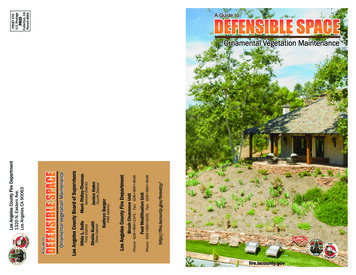
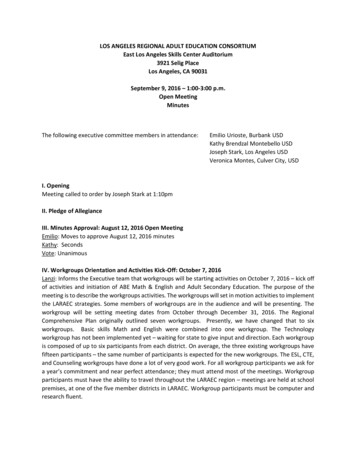
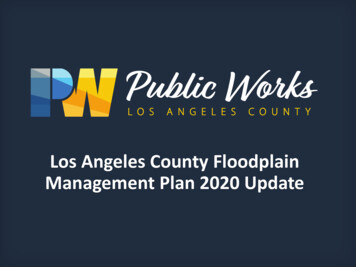
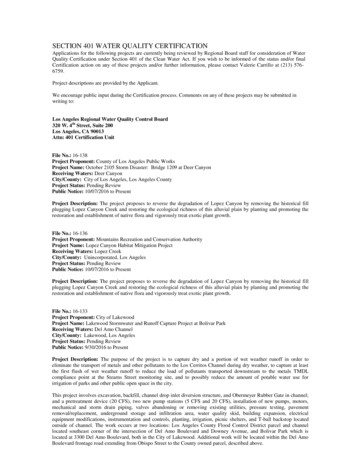

![bTBiesaFn Ep k BIsðèl EdleyIgsmnwgTTYl - calfund [.] org](/img/39/preschool-toolkit-cambodian.jpg)
